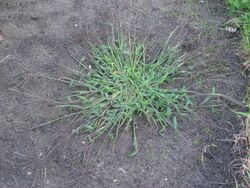Biology:Digitaria sanguinalis
| Digitaria sanguinalis | |
|---|---|

| |
| Scientific classification | |
| Kingdom: | Plantae |
| Clade: | Tracheophytes |
| Clade: | Angiosperms |
| Clade: | Monocots |
| Clade: | Commelinids |
| Order: | Poales |
| Family: | Poaceae |
| Subfamily: | Panicoideae |
| Genus: | Digitaria |
| Species: | D. sanguinalis
|
| Binomial name | |
| Digitaria sanguinalis | |
| Synonyms[1] | |
|
List
| |
Digitaria sanguinalis is a species of grass known by several common names, including hairy crabgrass,[2] hairy finger-grass,[3] large crabgrass, crab finger grass, purple crabgrass.[4] It is one of the better-known species of the genus Digitaria, and one that is known nearly worldwide as a common weed. It is used as animal fodder, and the seeds are edible and have been used as a grain in Germany and especially Poland, where it is sometimes cultivated.[5] This has earned it the name Polish millet.[6]
Description
It is an annual grass with an inflorescence of up to nine very long, very thin, radiating branches atop its stems. Each branch is lined with pairs of very tiny spikelets. The inflorescences may be reddish or purplish.
Uses
During the European Middle Ages, Digitaria sanguinalis was cultivated by Slavic peoples in Eastern Europe, where it was cooked in soups and porridges.[7]
The plant was brought to the United States by immigrants to serve as hand-foraged grain. The grass is also highly nutritious, especially before the plant exhausts itself producing seed. It is frequently sown in fields to provide graze for animals, or clipped and bundled as hay. Compared to other grasses, it has a relatively high protein percentage.[8] Farmers will sometimes till patches in their pastures in the late spring, with the intent of encouraging crabgrass seed.
For human consumption, crabgrass necessarily must be harvested by hand, because it produces grain throughout summer, rather than simultaneously. Machine harvesting would require monthly passes, and even then much of the seed would go to waste. Crabgrass produces an exceptionally high amount of grain, it smothers other weeds, it acts as its own mulch, and it can survive both heat and drought. Its adaptability makes it a candidate for environmental small-farming.[9]
Control
Its usefulness to nineteenth-century homesteaders has made its seed widespread, and today is generally considered an unattractive nuisance. Crabgrass takes advantage of low fertility and drought, since this tends to weaken other grasses and it tends to invade manicured turf. It is difficult to kill, as it will regenerate, and chemicals will likely harm surrounding grasses. As an annual, it can be controlled by preemergent herbicides. The most efficient means of control is to pull patches, and keep the rest of the lawn watered and mowed at a height of two to three inches.[10]
See also
- Digitaria compacta, raishan, used as a grain crop in northeast India
- Digitaria exilis, white fonio, used as a crop in West Africa
- Digitaria iburua, black fonio, used as a crop in West Africa
References
- ↑ "Digitaria sanguinalis (L.) Scop.". World Checklist of Selected Plant Families (WCSP). Royal Botanic Gardens (Kew). http://www.theplantlist.org/tpl1.1/record/kew-409361.
- ↑ "Digitaria sanguinalis". Natural Resources Conservation Service PLANTS Database. USDA. https://plants.usda.gov/core/profile?symbol=DISA. Retrieved 18 January 2016.
- ↑ (xls) BSBI List 2007, Botanical Society of Britain and Ireland, https://bsbi.org/download/3542/, retrieved 2014-10-17
- ↑ {{citation | mode = cs1 | title = Digitaria sanguinalis | work = Germplasm Resources Information Network (GRIN) | url = | publisher = [[Organization:Agricultural Research ServAgricultural Research Service (ARS), United States Department of Agriculture (USDA) | access-date = 6 February 2015 }}
- ↑ Georgia, Ada E. 1914. A Manual of Weeds. The Macmillan Company. Digitaria sanguinalis section
- ↑ Polish millet - Merriam-Webster Online(Subscription content?)
- ↑ Nesbitt, Mark (2005). Prance, Ghillean; Nesbitt, Mark. eds. The Cultural History of Plants. Routledge. p. 47. ISBN 0415927463.
- ↑ "Digitaria sanguinalis". http://www.pfaf.org/user/Plant.aspx?LatinName=Digitaria+sanguinalis.
- ↑ Green Deane. "Crabgrass Was King". http://www.eattheweeds.com/crabgrass-digitaria-sanguinalis-2/.
- ↑ Digitaria sanguinalis - Cabi
External links
Wikidata ☰ Q158994 entry
 |




